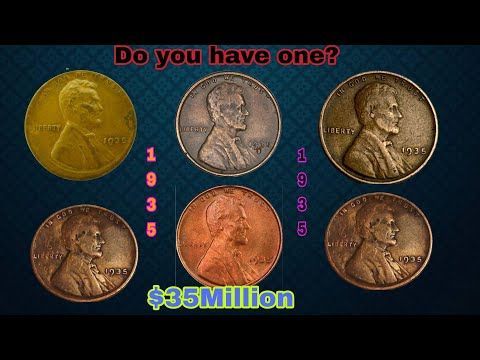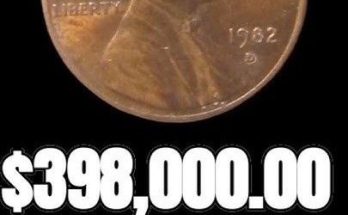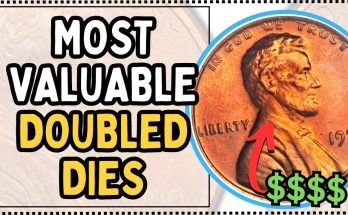You Won’t Believe This Wheat Penny Is Worth Millions – Rare Coins That Could Make You Rich!
The unassuming one-cent coin, the humble penny, is a staple of American currency. But buried within the decades of production for the beloved Lincoln Wheat Cent, minted from 1909 to 1958, are legendary minting errors and incredibly low-mintage issues that have become the stuff of numismatic legend. These are not just coins; they are hidden treasures, and some have commanded staggering prices at auction, with values pushing past the million-dollar mark. The next time you find a Wheat Penny, stop and inspect it closely—you could be holding a fortune in your hand!
The concept of a penny being “worth millions” is no exaggeration, as a few infamous production mistakes have created extreme rarity and incredible collector demand. The highest-valued Wheat Pennies are primarily error coins, the result of wartime material shortages or mechanical malfunctions at the US Mint. Learning to identify these rare varieties is the first step toward finding a life-changing windfall.
The Copper Catastrophe: The 1943 Bronze Cent
Perhaps the single most famous error coin in the entire series is the 1943 Copper (or Bronze) Cent. During World War II, copper was a critical war material, leading the US Mint to switch to a zinc-coated steel composition for the 1943 penny. However, a tiny number of copper blanks from 1942 were accidentally left in the presses and struck with the 1943 die.
These copper survivors are astoundingly rare—it is estimated that only about 20 of them exist. The scarcity and historical significance of this error have driven values into the stratosphere. A single 1943 Copper Penny sold at auction for $1.7 million in 2010, and experts now believe a top-condition specimen could fetch as much as $2.1 million.
How to Spot It: Since nearly all 1943 pennies are magnetic steel, the easiest test is to see if your 1943 coin sticks to a magnet. If it does not, and it has the reddish-brown color of copper, you may have one of the world’s most valuable error coins. You should also verify its weight; a genuine 1943 copper cent weighs 3.11 grams, while the common steel version weighs 2.7 grams.
The Reverse Flub: The 1944 Steel Cent
The year after the 1943 copper blunder, the US Mint reverted to a copper alloy for its pennies, using salvaged shell casings from the war effort. In a remarkable mirror error, a small number of leftover zinc-coated steel blanks from 1943 were mistakenly struck with the 1944 date. This created the incredibly rare 1944 Steel Cent.
The existence of the 1944 Steel Penny is confirmed by only a handful of examples, with the one struck at the Denver Mint (1944-D Steel Cent) being the most elusive, with only 7 to 10 known examples. The rarity is reflected in the prices, with the 1944-D steel penny achieving an auction record of approximately $1.7 million. Similarly, a 1944-S Steel Cent once sold for $408,000.
The Doubled-Up Delight: The 1955 Doubled Die Obverse
Another legendary Wheat Penny is the 1955 Doubled Die Obverse. This spectacular error occurred when the working die—the tool used to stamp the coin—was misaligned during the hubbing process, causing a double image. The result is a dramatic, easily visible doubling of the date “1955” and the mottos “LIBERTY” and “IN GOD WE TRUST”. Only about 20,000 of these striking coins were released into circulation before the mint noticed the error. Today, this famous variety can be worth a small fortune, with estimated values ranging from $1,000 to over $1,000,000 for specimens in pristine, uncirculated condition.
Low Mintage, High Value: The 1909-S VDB
Not all valuable coins are errors. Some are valuable simply due to extremely limited production runs, often called “key dates.” The first year of the Lincoln Cent, 1909, produced one of the most famous rarities: the 1909-S VDB. The “S” signifies it was minted in San Francisco, and the “VDB” stands for the designer’s initials, Victor David Brenner, which were quickly removed after public outcry. With a mintage of only 484,000, this coin is exceptionally rare. In top condition, a 1909-S VDB has reached an auction price of approximately $1.2 million. The 1914-D (Denver Mint) is another low-mintage key date, and a non-error coin that can be worth hundreds of thousands of dollars.
Final Advice
The odds of finding a $1 million Wheat Penny are slim, but not zero—these coins were, after all, released into circulation. Always handle a suspected rarity by the edges and never clean the coin, as cleaning can destroy its numismatic value. If you believe you have found one of these million-dollar coins, the next and most critical step is to have it authenticated and graded by a professional service like PCGS or NGC to confirm its authenticity and condition. The wealth you seek might be just a penny away.



